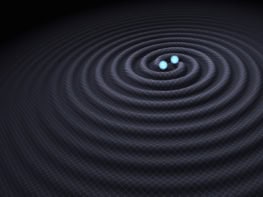Gianluigi Botton, head of the Diamond Light Source in Oxfordshire, talks to Joe McEntee about the £519m Diamond-II upgrade and what it means for the UK’s national synchrotron science facility

What is the Diamond Light Source?
The Diamond Light Source, which opened in 2007, is a 3 GeV synchrotron that provides intense beams of light that are used by researchers to study a wide range of materials. Diamond serves a user community of around 14,000 scientists working across all manner of fundamental and applied disciplines – from clean-energy technologies to pharma and healthcare; from food science to structural biology and cultural heritage.
And now you are planning a major upgrade, Diamond-II – what does that involve?
Diamond-II will consolidate our position as a world-leading facility, ensuring that we continue to attract the best researchers working in the physical sciences, life sciences and industrial R&D. At £519m, it’s an ambitious programme that will add three new beamlines – taking the total to some 35 – along with a comprehensive series of upgrades to the optics, detectors, sample environments, sample-delivery systems and computing resources across Diamond’s existing beamlines. Users will also benefit from new automation tools to enhance our beamline instrumentation and downstream data analysis.
What is the current status of Diamond-II?
Right now, we are in the planning and design phase of the project, although initial calls for proposals and specifications for core platform technologies have been put out to tender with industry suppliers. We will shut down the synchrotron in December 2027, with the bulk of the upgrade activity completed in summer 2029. From there, we will slowly ramp back up to fully operational by mid-2030, although some beamlines will be back online sooner.
What roles are other advanced light sources playing in Diamond-II?
Even though synchrotron facilities are effectively in competition with each other – to host the best scientists and to enable the best science – what always impresses me is that collaboration and partnership are hard-wired into our community model. At a very basic level, this enables phased scheduling of the Diamond-II upgrade in co-ordination with other large-scale facilities – mainly to avoid several light sources going dark simultaneously.
How is this achieved?
Diamond’s Machine Advisory Committee – which comprises technical experts from other synchrotron facilities – plays an important networking role in this regard, while also providing external challenge, sense-check and guidance when it comes to review and iteration of our technical ambitions. In the same way, we have engaged extensively with our user community – comprising some 14,000 scientists – over the past decade to ensure that the users’ priorities underpin the Diamond-II science case and, ultimately, that we deliver a next-generation facility with analytical instruments that meet their future research needs.
You’ve been chief executive officer of Diamond since October 2023. What does your typical day look like?
Every day is different at Diamond – always exciting, sometimes exhausting but never dull. At the outset, my number-one priority was to engage broadly with our key stakeholders – staff teams, the user community and the funding agencies – to build a picture of how things work and fit together. That engagement is ongoing, with a large part of the working day spent in meetings with division directors, senior managers and project leaders from across the organization. The task is to figure out what’s working, what isn’t and then quickly address any blockers.
I want to hear what our people really think; not what they think I want to hear
How do you approach this?
Alongside those formal meetings, I try to be visible and available whenever possible. Ad hoc visits to the beamlines and the control room, for example, mean that I can meet our scientists, technicians and support staff. It’s important for staff to have the opportunity to talk candidly and unfiltered with the chief executive officer so that I can understand the everyday issues arising. I want to hear what our people really think; not what they think I want to hear.
How do you attract and retain a diverse workforce?
Diamond is a highly competitive research facility and, by extension, we are able to recruit on a global basis. Diversity is our strength: the best talent, a range of backgrounds, plus in-depth scientific, technical and engineering experience. Ultimately, what excites many of our scientists and engineers is the opportunity to work at the cutting edge of synchrotron science, collaborating with external users and translating their research objectives into realistic experiments that will deliver results on the Diamond beamlines. One of my priorities as chief executive officer is to nurture and tap into that excitement, creating a research environment where all our people feel valued and can see how their individual contribution is making a difference.
How is Diamond optimizing its engagement with industry?
Industry users account for around 5% of beamtime at Diamond – and we co-ordinate that effort on multiple levels. To provide strategic direction, there’s the Diamond Industrial Science Committee, with senior scientists drawn from a range of industries advising on long-term applied research requirements. At an operational level, we have the Industrial Liaison Office, a multidisciplinary team of in-house scientists who work closely with industrial researchers to address R&D problems across diverse applications – from drug discovery and catalysis to aerospace and automotive.

What about equipment manufacturers?
Our scientists and engineers also maintain ongoing collaborations with equipment manufacturers – in many cases, co-developing custom technologies and instrumentation to support our infrastructure and research capability. Those relationships are a win-win, with Diamond’s leading-edge requirements often shaping manufacturers’ broader product development roadmaps.
Has Brexit had any impact on Diamond?
While Diamond’s relationship with Europe’s big-science community took a hit in the aftermath of Brexit, we are proactively rebuilding those bridges. Front-and-centre in this effort is our engagement in the League of European Accelerator-based Photon Sources (LEAPS), a strategic consortium initiated by the directors of Europe’s synchrotron and free-electron laser facilities. Working together, LEAPS provides a unified voice and advocacy for big science – engaging with funders at national and European level – to ensure that our scientists feel more valued, not only in terms of career pathways and progression, but also financial remuneration.
Is the future bright for synchrotron science?
We need big science to tackle humanity’s biggest challenges in areas such as health, medicine, energy, agriculture and sustainability. These grand challenges are a team effort, so the future is all about collaboration and co-ordination – not just between Europe’s advanced light sources, but other large-scale research facilities as well. To this end, Diamond has been, and remains, a catalyst in bringing together the global light sources community through the work of Lightsources.org.



